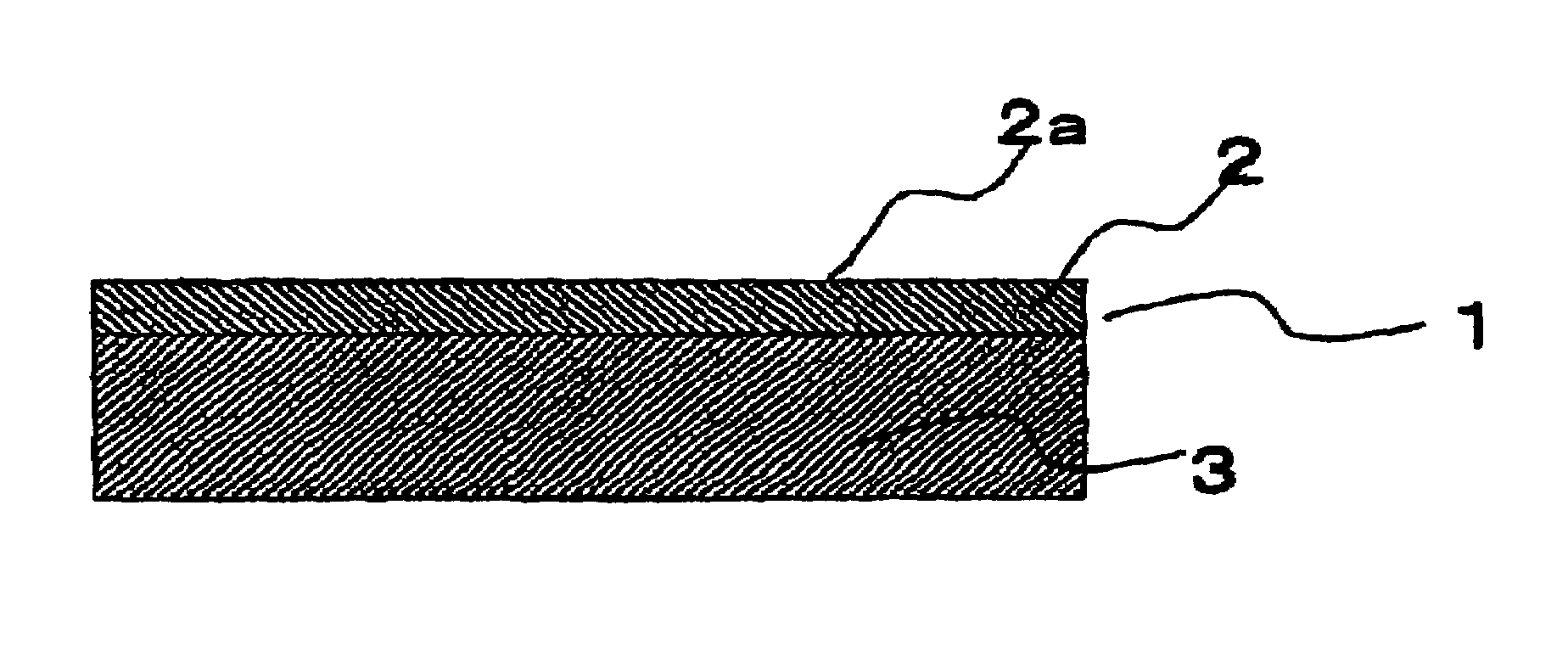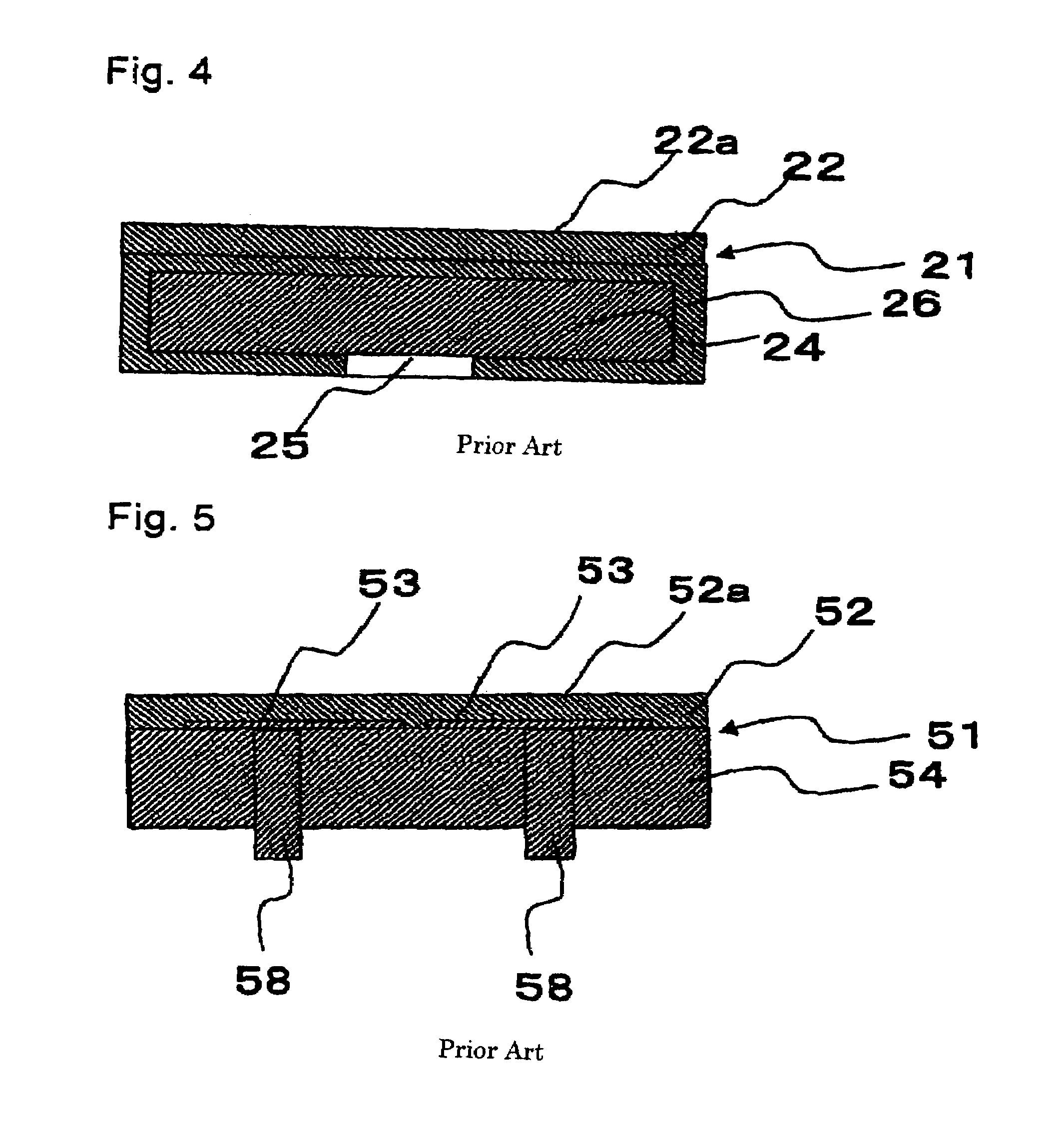Electrostatic chuck
a technology of electrostatic chuck and chuck body, which is applied in the direction of electrostatic holding device, basic electric elements, electric apparatus, etc., can solve the problems of heat resistance properties, requiring smoothness and lack of pinhole, and insulating film b>52/b> might be broken, etc., to prevent insulation breakdown, excellent characteristics of releasing the wafer w, excellent durability against plasma
- Summary
- Abstract
- Description
- Claims
- Application Information
AI Technical Summary
Benefits of technology
Problems solved by technology
Method used
Image
Examples
example 1
[0086]A porous body of SiC with a diameter of 198 mm and a thickness of 5 mm was impregnated with aluminum alloy to form a layer of aluminum alloy with a thickness of 1 mm on the side face and the top and bottom faces, obtaining the conductive base 3 with a diameter of 200 mm and a thickness of 7 mm, which contained 80 mass % of SiC and 20 mass % of aluminum alloy. Next, an insulating film of a ceramics was formed on the top surface to make samples of No. 1 to 11, which were evaluated on items of insulation breakdown, cracking, flaking, plasma-resistance of the insulating film.
[0087]The insulation breakdown of the insulating film was evaluated in whether the insulation was broken down or not when a voltage of 3 kV was applied between the wafer and the conductive base 3.
[0088]Further, regarding the evaluation on the plasma-resistance of the insulating film, the placing surface was exposed for 100 hours in plasma which was generated between the placing surface and an opposite electrod...
example 2
[0099]Secondly, using the conductive base 3 with a diameter of 200 mm and a thickness of 7 mm as used in Example 1, and an insulating film 2 of amorphous aluminum oxide, various films were deposited while changing the amount of argon contained in the amorphous ceramic insulating film 2 under various deposit conditions. Whether flaking and cracking occurred or not was evaluated.
[0100]
TABLE 2sampleamount ofcracking,insulation breakdownNo.argon (atom %)flakingof insulating film210.5yes—221nono233nono246nono2510nono
[0101]The sample No. 21, which had the smaller amount of argon of 0.5 atom %, showed cracking occurred in the insulating film.
[0102]However, the samples No. 22 to 25, which had the amount of argon of 1 to 10 atom % according to the present invention, showed no cracking and no insulation breakdown occurred in the insulating film. Therefore, it can be seen that the amount of argon is preferably 1 to 10 atom %.
[0103]Next, using the conductive base 3 with a diameter of 200 mm and...
example 3
[0109]Samples No. 41 to 44, in which material of the insulating film of amorphous ceramics was aluminum oxide, yttrium oxide, yttrium-aluminum oxide, or cerium oxide, respectively, and a comparative sample No. 45, in which the insulating film was formed of polycrystal alumina, were exposed in plasma, then each etching rate of the insulating film was compared.
[0110]In the evaluation way, in a state that the outer circumferential top face and the side face of the electrostatic chuck were provided with a cover ring to cover areas having no insulating film, the surface of the insulating film was exposed in plasma. Regarding the plasma condition, the insulating film was exposed for 2 hours in plasma which was generated between the placing surface and an opposite electrode, which was located above the placing surface, by supplying a radio frequency power of 2 kW between the opposite electrode and the conductive base with a halogen gas of Cl2 flowing at 60 sccm and a vacuum degree of 4 Pa....
PUM
| Property | Measurement | Unit |
|---|---|---|
| thickness | aaaaa | aaaaa |
| thickness | aaaaa | aaaaa |
| thickness | aaaaa | aaaaa |
Abstract
Description
Claims
Application Information
 Login to View More
Login to View More - R&D
- Intellectual Property
- Life Sciences
- Materials
- Tech Scout
- Unparalleled Data Quality
- Higher Quality Content
- 60% Fewer Hallucinations
Browse by: Latest US Patents, China's latest patents, Technical Efficacy Thesaurus, Application Domain, Technology Topic, Popular Technical Reports.
© 2025 PatSnap. All rights reserved.Legal|Privacy policy|Modern Slavery Act Transparency Statement|Sitemap|About US| Contact US: help@patsnap.com



